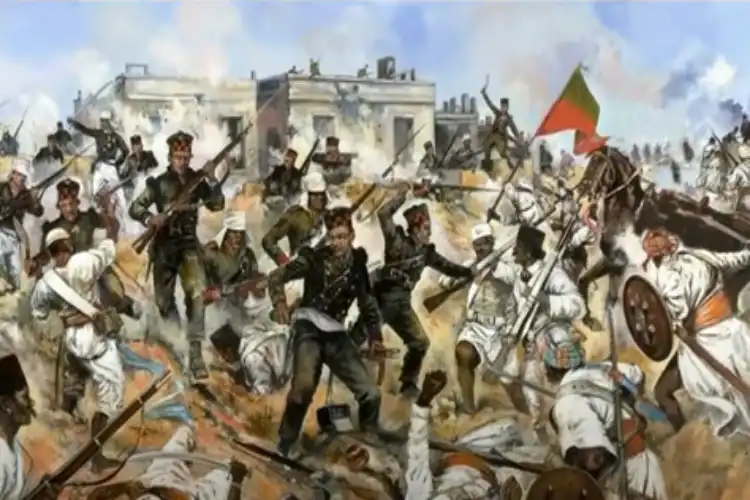Saquib Salim
The First War of National Independence fought in 1857 was unique in the sense that it was the first nationwide armed movement to kick the English out of Indian soil. However, surely it wasn’t the first such revolt by the Indians against English Rule. The events of 1857 were largely inspired by another similar event of 1806.
On June 10, 1806, the Indian sepoys of the English East India Company Army mutinied at Vellore and killed English officers. Tipu Sultan, one of the most formidable armed opposition to the English expansion in South India, lost his life on the battlefield only seven years ago and his family was kept safe at Vellore Fort. If Bahadur Shah Zafar was a descendant of former rulers in 1857, heirs of Tipu Sultan were to be claimed the leader of the revolt. In 1857 Tantia Tope provided the military strategy, a role played by Holkars in 1806. The spontaneous cause for the mutiny was the compulsion of wearing European dress and giving up religious signs, later in 1857 greased cartridges became a major factor.
The similarities did not end here. Much like 1857 was not limited to Meerut, the revolt of 1806 had spread, and religious mendicants, especially Fakirs, played an important role in carrying revolutionary messages from one place to another and inciting anti-English sentiments among the sepoys.
Those days Fakirs and Sanyasis were hired by royal armies during armed expeditions. After the defeat of Siraj ud-Daulah at Plassey in 1757, Fakirs and Sanyasis led an armed struggle in Bengal, Bihar, Odisha, and parts of Uttar Pradesh. By 1800, the English armies, with the help of Indian states, considerably suppressed them but Fakirs had other plans. They joined the armies of Jaipur, Scindia, Holkars, and others who were fighting against the foreign rulers at the time.
The sacrifice of Tipu was a setback for nationalists and they wanted to regain the lost ground. Marathas led by Holakrs planned a revolt from within the English East India Company Army. Holkars, Scindias, a brother of Nizam of Hyderabad and sons of Tipu Sultan plotted a mutiny of Indian sepoys in the English army after which armies of Holkars would come down to South India to kill the English.
Thousands of Fakirs were sent to Bangalore, Vellore, Bellary, Nandi Hills, Chennai, and other English cantonment cities. They organised puppet shows near cantonments themed around the struggle of England and France where France emerged victorious. Fakirs also sang songs and told stories praising the valour of Tipu. Propaganda was also undertaken to convince Hindus and Muslims that the English were trying to convert them to Christianity. Muslim Fakirs were not alone, Saints of the Lingayat caste also participated in this campaign.
Abdullah Khan and Peerzada, both close associates of Tipu, were important leaders of Fakirs in Bangalore and Vellore. In Vellore, Rustam Ali was identified as one of the important men who incited the sepoys against the English. Nabi Shah, one of the spiritual guides of Tipu, organized Muharram where songs were sung in praise of Tipu, and those helping the English were denounced. On 10 June 1806, sepoys at Vellore mutinied. It was premature and other centers did not rise in revolt. Sons of Tipu were proclaimed the leaders of the revolt.
Shaikh Adam, a Fakir, distinguished himself as the leader of revolutionaries at Vellore. The revolutionaries killed several English but the mutiny was suppressed. Fakirs could not be caught and they kept planning uprisings at other cantonments. They started singing songs in praise of martyrs at Vellore. In August, September, October, and November the fire had spread to places like Hyderabad, Chennai, and Nandi Hills. Aleem Ali Shah and Noor Khalil Shah were leading Fakirs at Bellary.
In Nandi Hills, Fakirs were telling people that Polygars, Marathas, and Tipu’s loyalists would rise and the Indian sepoys should help them. The English officers noted that Hindus and Muslims both were ready to fight them. Hyderabad also witnessed an agitation of Indian sepoys in July.
The British remained puzzled by the revolts in South India and could not understand why and how they occurred. Perumal Chinnian writes, “the Southern conspiracy was supported by Fakirs and other religious mendicants. The conspiracy was established in all the army stations by them.”
Also Read: Raja Mahendra Pratap believed in religion of human love
The blueprint was made in 1806, which Mubariz ud-Daula tried to execute in 1838, Khwaja Hasan Ali Khan and Kunwar Singh attempted to realize it in 1846, and was more successfully implemented by several leaders together in 1857.

